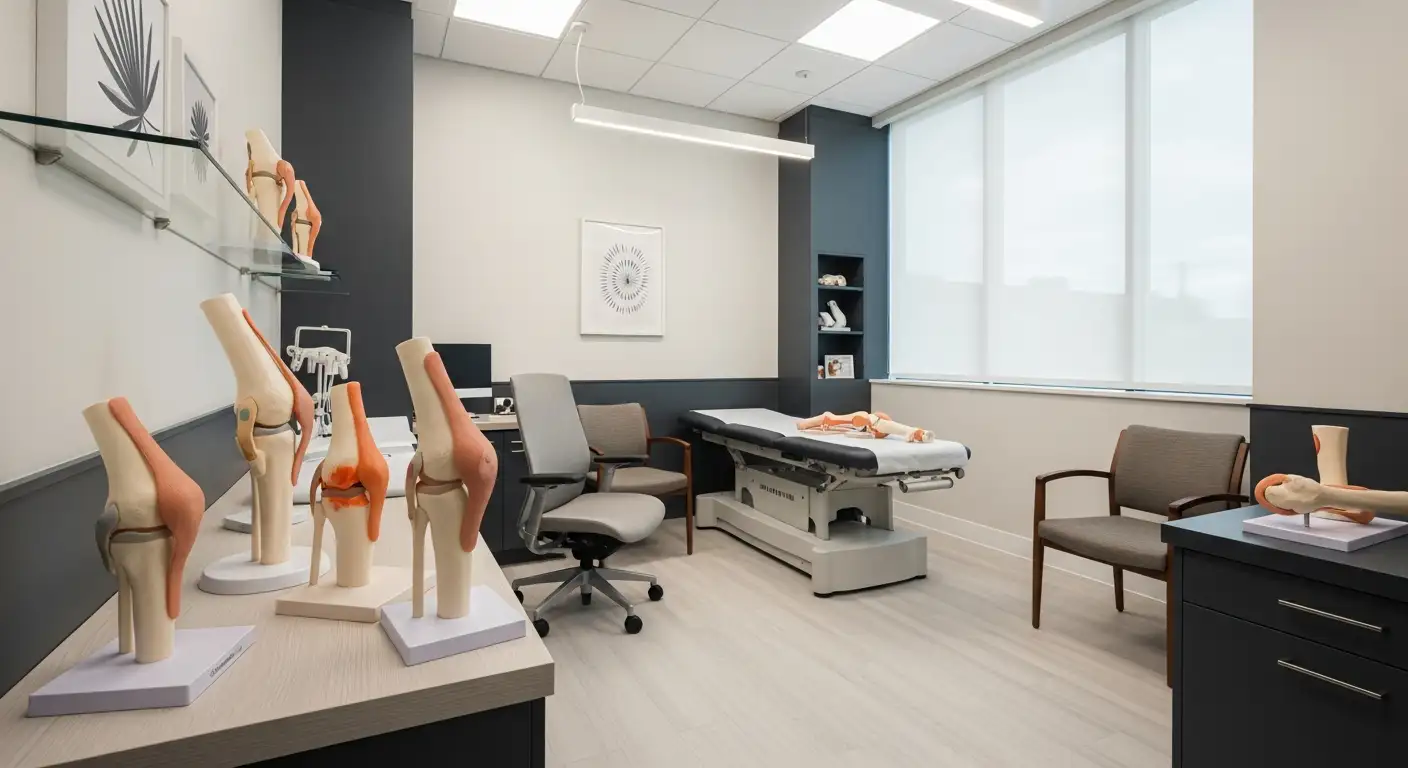Introduction to Post-Surgical Knee Pain Management
Post-surgical knee pain is a common concern for many patients following procedures such as total knee arthroplasty or arthroscopy. Corticosteroid injections have emerged as a frequently used intervention to mitigate inflammation and alleviate discomfort. This article delves into how these injections work, their effectiveness, potential risks, and guidelines for their use, offering a comprehensive overview to inform patients and healthcare providers alike.
Mechanisms of Corticosteroid Action in Post-Surgical Knee Pain

How do corticosteroid injections work for post-surgical knee pain?
Corticosteroid injections mainly aim to reduce inflammation, which is often a core cause of pain after knee surgery. When injected into the joint or surrounding soft tissues, these drugs limit the dilation and permeability of blood vessels. This action reduces the influx of inflammatory cells and the release of inflammatory mediators.
Within the molecular framework, corticosteroids bind to nuclear steroid receptors inside cells. This binding inhibits the transcription of genes responsible for producing inflammatory substances. As a result, there is decreased production of prostaglandins, leukotrienes, and enzymes that can damage joint and tissue structures.
Beyond their chemical interactions, corticosteroids help mechanically alleviate pain by reducing swelling and fluid build-up. They may also break down scar tissue or facilitate drainage within the joint, contributing to immediate relief.
It’s important to note that while they provide effective short-term pain control, their long-term benefits are limited. Excessive or repeated injections can pose risks such as cartilage deterioration or infection. Nonetheless, for post-surgical knee pain, corticosteroids serve as a valuable tool to manage inflammation quickly and improve mobility during recovery.
Clinical Effectiveness of Corticosteroid Injections Post-Surgery

What is the effectiveness of corticosteroid injections after knee surgery?
Corticosteroid injections, administered after knee surgeries, have been shown to provide notable relief from pain, inflammation, and swelling. Many patients report experiencing substantial improvements for more than a month post-injection. These injections work by calming the immune response locally, which reduces inflammation and enhances joint function.
Research indicates that patient-reported outcomes generally reflect increased satisfaction, with factors such as pain reduction and improved mobility being prominent. Studies also highlight that these injections can significantly diminish the need for additional postoperative analgesics, allowing patients to recover more comfortably and potentially accelerating functional recovery.
Furthermore, corticosteroid injections are considered a safe and effective adjunct in managing postoperative knee pain, especially when imaging guidance, such as ultrasound, is used to ensure precise delivery. Importantly, available evidence has not linked intra-articular corticosteroid use to increased risks of infections or adverse events in relatively healthy, younger populations.
However, some complex relationships have been observed between corticosteroid injections and long-term outcomes, including the potential influence on the rate of subsequent knee replacements. Due to residual confounding factors in many studies, results should be interpreted cautiously. Nonetheless, overall, corticosteroid injections remain a valuable tool in enhancing postoperative comfort and facilitating rehabilitation.
Risks and Safety Considerations for Post-Surgical Corticosteroid Use

What are the risks and side effects associated with corticosteroid injections in post-surgical knees?
Corticosteroid injections in knees that have already undergone surgery can be beneficial for managing inflammation and pain. However, they also pose certain risks. Local side effects may include pain at the injection site, skin discoloration, thinning of the skin, fat atrophy, and, rarely, infection. These injections can also increase the risk of tendon rupture or further joint degeneration if misused.
Systemically, corticosteroids can elevate blood sugar levels, which is especially concerning for diabetics. Other potential systemic effects include increased blood pressure, reduced bone density leading to osteoporosis, and adrenal suppression if taken repeatedly. There is also a small chance of a post-injection flare—a temporary increase in pain—which usually resolves quickly.
Patients with infections, bleeding problems, or uncontrolled metabolic conditions should be cautious. Overall, while corticosteroid injections offer quick relief, their use in post-surgical knees must be carefully considered and monitored by healthcare professionals.
Guidelines and Recommendations for Postoperative Corticosteroid Use
 What guidelines exist for the use of corticosteroid injections following knee surgery?
What guidelines exist for the use of corticosteroid injections following knee surgery?
Corticosteroid injections are commonly used to manage inflammation and pain in various joint conditions, including post-surgical inflammation after knee procedures. However, their application following knee surgery, particularly total knee arthroplasty (TKA), requires careful consideration.
Existing guidelines recommend cautious use of corticosteroid injections postoperatively. It is generally advised to avoid injecting steroids within the three months prior to scheduled knee replacement surgery, as this interval helps reduce the risk of postoperative infections, including periprosthetic joint infections (PJI). Studies have shown that injections administered too close to surgery can elevate infection risk due to immune suppression and local tissue effects.
The American Academy of Orthopaedic Surgeons (AAOS) 2013 guidelines do not strongly endorse intra-articular corticosteroids for long-term management but acknowledge their short-term benefits for pain relief lasting weeks to months. They emphasize that injections should be considered on a case-by-case basis, weighing the potential benefit of pain reduction against possible adverse effects, such as cartilage damage or increased susceptibility to infection.
Ultrasound guidance for injections is recommended to improve accuracy, reduce procedural discomfort, and ensure precise delivery into the joint space. Lower doses, such as 20 mg of triamcinolone, are effective and are associated with a lower likelihood of side effects compared to higher doses like 40 mg.
Timing constraints are crucial. Administrations should be spaced at least 2–3 weeks apart if multiple injections are necessary, with a maximum of three to four injections per year to prevent joint deterioration. It is vital to avoid injections in the period immediately preceding surgery to mitigate the risk of postoperative complications.
Moreover, contraindications such as active infection, joint fracture, hypersensitivity, and coagulopathies must be considered. Patients with diabetes or compromised immune systems require extra caution because corticosteroids can elevate blood sugar levels and suppress immune responses.
Overall, the use of corticosteroid injections after knee surgery should be individualized, with detailed patient counseling on potential risks and benefits. Close coordination with the surgical team and adherence to recommended timing can optimize outcomes while minimizing adverse effects.
Patient Selection Criteria for Post-Surgical Corticosteroid Therapy
Choosing the right candidates for corticosteroid injections after knee surgery involves careful evaluation of several factors. Patients' overall health status is a primary consideration. Those with active infections or systemic illnesses are typically contraindicated, as corticosteroids can suppress immune response and worsen infections.
Another critical aspect is the stage of tissue healing. Injections are often avoided in the early healing phase post-surgery to prevent interfering with tissue repair processes. Timing is essential; waiting until initial inflammation subsides can reduce potential complications.
The underlying cause of ongoing knee pain is also key. Corticosteroids are most effective when used for degenerative conditions like osteoarthritis or inflammatory statuses such as bursitis or synovitis. For pain due to other causes, alternative treatments may be preferred.
Past response to injections provides valuable insight. Patients who have experienced significant relief from previous corticosteroid treatments are more likely to benefit again. Dosing strategies, including higher doses such as 50 mg prednisone equivalents, may be considered for longer-lasting effects, but these should be balanced against the risk profile.
Safety and potential risks, such as cartilage deterioration, joint infection, or tendon damage, are carefully weighed against expected benefits. Repeated injections should be limited, typically not exceeding four per year, to mitigate adverse effects.
Beyond corticosteroids, other options like hyaluronic acid or platelet-rich plasma (PRP) might be appropriate based on individual patient needs and response history. Tailoring treatment plans ensures optimized outcomes and minimizes risks.
The decision to administer corticosteroid injections should always involve a comprehensive assessment, considering diagnosis, previous treatment responses, timing relative to surgery, and overall health to achieve the best possible results while safeguarding patient safety.
Scientific Evidence Supporting Postoperative Use of Corticosteroids
Research and trial data on efficacy and safety
Numerous high-quality clinical studies have explored the role of corticosteroid injections in managing postoperative knee pain. Randomized controlled trials (RCTs) have consistently shown that intra-articular corticosteroids can significantly alleviate pain and improve joint function after knee surgeries, including arthroscopy and total knee replacement (TKA). Systematic reviews pool these results to verify that patients experience reduced pain scores, decreased swelling, and enhanced mobility.
In particular, post-surgical use of corticosteroids has demonstrated rapid pain relief within the first few days to weeks, delaying the need for additional pain medication such as opioids. Many studies also report increased patient satisfaction and quicker functional recovery, with some positive effects lasting up to a month or longer.
Summary of high-quality clinical evidence
The strongest evidence comes from randomized controlled trials that compare corticosteroid injections combined with standard care versus placebo or no injection. These trials confirm that corticosteroids lead to significant reductions in inflammatory markers and joint tenderness. Moreover, ultrasound-guided injections improve the accuracy, further enhancing safety and outcomes.
A notable meta-analysis highlights that corticosteroid injections reduce postoperative pain at rest and during movement, as well as lower the total consumption of narcotics. Additionally, they are associated with fewer hospital visits and reduced need for physical therapy in some cases.
Potential long-term concerns and adverse effects
Despite their benefits, concerns about long-term safety persist. Repeated intra-articular steroid injections may accelerate cartilage degeneration and contribute to joint degradation over time. Evidence from observational studies suggests that multiple injections within a year could lead to adverse structural changes, including osteonecrosis or increased joint space narrowing.
Furthermore, systemic side effects, though rare in short-term use, can include elevated blood sugar levels, suppression of adrenal function, and osteoporosis if injections are administered improperly or excessively. There is also a risk of infection, particularly if aseptic techniques are not meticulously followed.
Current guidelines recommend cautious use, limiting the number of injections—generally to three or fewer per year—and ensuring proper timing between doses. Overall, when used judiciously and with appropriate technique, corticosteroid injections remain a valuable tool for managing postoperative knee pain, with a favorable safety profile supported by current evidence.
Procedural and Post-Injection Management Considerations
When administering corticosteroid injections into the knee, several procedural steps are vital to ensure safety and effectiveness.
Firstly, thorough evaluation of the patient is necessary, including reviewing joint health and considering any contraindications such as active infection or bleeding disorders. Imaging guidance, typically ultrasound or fluoroscopy, enhances accuracy by confirming proper needle placement within the joint space. These imaging techniques reduce the risk of misplacement, which can lead to suboptimal results or complications.
The injection approach should be selected based on anatomical considerations. Common access points include superolateral, superomedial, or anteromedial/anterolateral routes. The choice depends on the ease of access and the ability to reach the synovial cavity effectively. Ultrasound or fluoroscopy can guide needle placement precisely, especially in patients with difficult anatomy or prior joint procedures.
Aseptic technique is critical during the procedure. This involves sterilizing the skin using alcohol or chlorhexidine, using sterile gloves and equipment, and minimizing contamination risks. Proper sterilization minimizes the chance of introducing bacteria into the joint, which can cause infection.
It is important to ensure that the corticosteroid and anesthetic doses are correctly prepared and administered. Typical steroids include triamcinolone or methylprednisolone, and the dose varies depending on the condition and joint size, with standard doses around 40 mg for the knee.
Post-injection, careful monitoring for immediate issues such as allergic reactions, bleeding, or severe pain is necessary. Patients should be advised to decrease weightbearing temporarily, usually for next 48 hours, to facilitate healing and reduce stress on the joint.
Managing post-injection symptoms is also crucial. Pain flare-ups are common and can be relieved with ice application and over-the-counter NSAIDs. Patients must be educated about signs of infection, like increased swelling, redness, warmth, or fever, which require prompt medical attention.
In addition, timing of activity resumption plays a role. Light activities like walking are generally encouraged, but strenuous activities should be avoided for several days. Return to vigorous exercise or sports is typically delayed until any immediate reactions subside.
In summary, effective corticosteroid knee injections depend on precise procedural execution, careful patient assessment, sterile technique, and appropriate post-procedure care to both maximize benefits and minimize risks.
Post-Treatment Care and Activity Guidelines After Corticosteroid Injections
What post-treatment care is recommended after corticosteroid injections for knee pain?
Following corticosteroid injections into the knee, proper post-treatment care is essential to maximize benefits and minimize risks. Patients are typically advised to rest the joint for at least 24 to 48 hours after the procedure. In some cases, healthcare providers may recommend extending the rest period up to seven days, especially if multiple injections are performed or if specific complications are anticipated.
During this initial recovery phase, strenuous activities should be avoided. Activities that put stress on the knee, such as high-impact sports or heavy lifting, should be postponed. Short, gentle walks are generally safe and encouraged, but it’s important not to overexert the joint.
Applying ice or cold packs to the injection site for 10 to 20 minutes can help reduce pain, swelling, and inflammation. Over-the-counter pain relievers like acetaminophen or NSAIDs may be used as needed, but patients should follow their healthcare provider’s advice regarding medication use.
Gradual resumption of activities is recommended based on individual response and comfort. Gentle movement can promote circulation and help prevent stiffness, but any activity causing increased pain should be minimized.
Close monitoring for adverse reactions is crucial. Patients should watch for signs of increased swelling, persistent pain, warmth, redness, or any signs of infection. If any concerning symptoms develop, prompt communication with the healthcare provider is necessary.
Follow-up appointments are important to evaluate the effectiveness of the injection and to address any complications early. Healthcare providers often give specific activity restrictions tailored to the individual’s condition and response to treatment.
In summary, the recommended post-treatment care involves a balance of rest, gradual activity, symptom monitoring, and timely follow-up to ensure optimal recovery and pain relief.
Final Thoughts on Corticosteroid Use Post-Surgery
Corticosteroid injections play a valuable role in managing post-surgical knee pain by reducing inflammation, alleviating pain, and improving mobility in the short term. While their benefits are well-documented, careful patient selection, adherence to guidelines, and vigilant monitoring for side effects are essential to maximize safety and effectiveness. Given ongoing research into long-term outcomes and the potential risks, corticosteroids should be used judiciously within a comprehensive pain management plan, tailored to individual patient needs and clinical scenarios.
References
- Intra-Articular Corticosteroid Injection After Total Knee Replacement
- Cortisone Shots (Steroid Injections): Benefits & Side Effects
- Knee Injections for Pain Relief - Johns Hopkins Medicine
- The Role of Corticosteroid Injections in Knee Pain Relief
- Cortisone Shot (Steroid Injection) - OrthoInfo - AAOS
- Cortisone shots - Mayo Clinic
- Use and safety of corticosteroid injections in joints and ...





